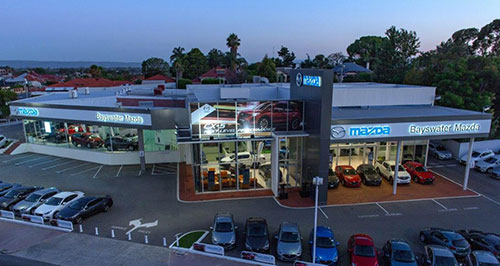Make / Model Search
News - General NewsMazda, Ford top sales satisfaction tableOngoing battle: Perennial rivals Ford and Holden have taken turns to join Mazda at the top of JD Power’s Australian Sales Satisfaction Index survey. Ford replaces Holden as joint leader with Mazda in JD Power Sales Satisfaction IndexGallery Click to see larger images 14 Nov 2019 FORD has usurped arch-rival Holden in joining reigning Mazda at the top of JD Power’s latest Sales Satisfaction Index (SSI) survey of 3217 Australian new-vehicle customers who purchased or leased their vehicle between February 2018 and August 2019.
A resurgent Mercedes-Benz also regained the number-one spot from BMW as leader of the SSI rankings for luxury car brands, having comfortably topped the table in 2017.
This is the last syndicated JD Power study planned for Australia before the industry research specialist pulls out of this market as its presence in Asia and Oceania is rolled back to focus on China and Japan under new owner, private equity firm Thoma Bravo.
Compared with the 2018 SSI survey, the overall industry has upped its game, elevating the mass-market average from 802 points to 817 while the luxury brand average has climbed from 835 points last year to 857.
For the mass market this represents a recovery and a tiny one-point improvement over the 2017 average, while the top end of town has continued its upward streak from 2017, when it averaged 823 points.
Mazda, which has topped three out of the four SSI surveys run by JD Power in Australia, leads this year’s mass-market rankings along with Ford with 835 out of a maximum 1000 points.
The latest survey results reveal a 13-point uptick for Mazda and 33 extra points for Ford, which last year was lineball with the mass-market average.
By contrast Holden has dropped below the mass-market average with 810 points in the latest SSI survey, behind Toyota, Subaru, Mitsubishi and Hyundai.
Mercedes-Benz sailed 11 points above the luxury average with 878 points, quite an improvement over last year’s third-place result when it dragged down the overall average with an 814-point performance.
This year, Audi drops from second rank to third with 822 points, while second-placed BMW is slightly below average on 855 points, having previously smashed the 2018 average by 26 points.
Among mass-market players – apart from Toyota hanging onto the number-three spot with 827 points (up from 815 last year) – the rest of the top-10 table has undergone a thorough reshuffle.
Big improvers include Subaru, which has leapt from equal eighth to fourth in 2019 (with 822 points) and Mitsubishi (up from 10th to fifth with 818 points).
Hyundai, which topped the table in 2017, has moved from bottom of the leading brands to just below average with 812 points.
In points terms, Volkswagen was remarkably consistent with 802 points this year and 801 in 2018, but is now placed 10th due to the overall market improvement. Similarly, Nissan dropped from fourth to eighth despite a two-point improvement to 806 points.
Kia scored 791 points last year for joint-eighth place with Subaru but its eight-point improvement in 2019 still ranked it at the bottom of this year’s leading brands. For the same reason, Honda dropped two places to ninth position in 2019 despite its 805 points being 10 more than before.
JD Power identified interaction with product specialists and post-purchase demonstration of vehicle features as opportunities for brands to improve their SSI scores.
Among mass-market buyers surveyed, just 20 per cent said they had dealt with a product specialist during the purchase process compared with 37 per cent of luxury car buyers. JD Power says these interactions increase satisfaction from 809 points to 851 for mass-market brands and up from 833 to 897 in the luxury market.
JD Power Australia director and country manager Bruce Chellingworth described product specialists as “an important lever” for dealerships to effectively demonstrate product features throughout the sales process.
“Dealers should take the opportunity to demonstrate new features, from the moment customers go onto dealership websites to the time they purchase and not just engage at the final delivery stage,” he said.
Overall, 37 per cent of respondents said they were given a post-purchase run-through of features such as audio, Bluetooth, communications, navigation and safety systems. JD Power found these follow-ups to provide a huge boost in satisfaction, upping the index points from 792 to 871.
Another finding of the 2019 SSI study was that customers whose test drive lasted more than 30 minutes awarded the dealer an additional 31 satisfaction points, with 56 per cent of respondents having less than 20 minutes behind the wheel before signing on the dotted line.
Dealers using tablets, smartphones and touchscreen monitors during the sales process also received higher satisfaction scores, with 60 per cent of mass-market buyers experiencing this compared against 73 per cent of luxury buyers. Customers experiencing this use of technology respectively upped their satisfaction scores by 55 and 69 points.
Pushy salespeople could undo an otherwise positive purchasing experience, with respondents experiencing this – 21 per cent mass-market, 17 per cent luxury – deducting a substantial 75 satisfaction points and slashing the chances of the customer recommending the dealership to others by 20 percentage points in the mass market and 15 percentage points among luxury buyers.  Read more1st of February 2019  The best brands for sales satisfactionMazda, Holden, BMW on top of 2018 JD Power SSI study but industry needs to lift game10th of October 2017  Exclusive: Mercedes beats rivals for sales satisfactionJD Power SSI study of luxury brands ranks Mercedes well ahead of Audi, BMW |
Click to shareGeneral News articlesResearch General News Motor industry news |













Facebook Twitter Instagram